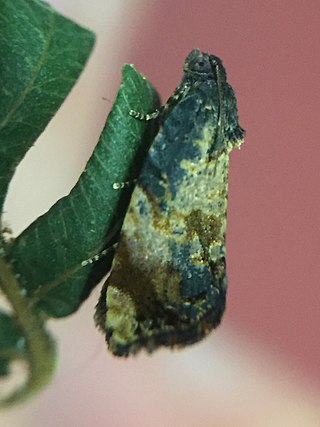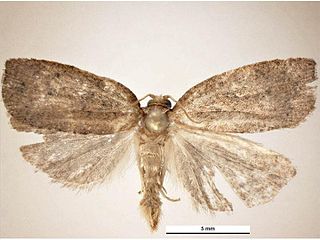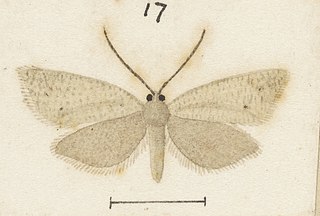
Philocryptica is a monotypic genus of moths belonging to the subfamily Tortricinae of the family Tortricidae. It contains only one species, Philocryptica polypodii, the leather-leaf star-miner, which is endemic to New Zealand. This species has been recorded in both the North Island and the South Island, as far south as Banks Peninsula. The preferred habitat of this species is native forest where the species' larval host is present. The larvae feed on Pyrrosia eleagnifolia, mining the host plant leaves. P. polypodii pupates within the final blotch-mine. Adults are on the wing in November and December.

Planotortrix is a genus of moths belonging to the subfamily Tortricinae of the family Tortricidae.

Planotortrix excessana, the greenheaded leafroller, is a moth of the family Tortricidae. It is native to New Zealand and is an introduced species in Hawaii. It is extremely variable in appearance and feeds on many native and introduced species. It is regarded as a pest of some agricultural and forestry crops.

Cryptaspasma querula is a moth of the family Tortricidae. It is endemic to New Zealand and can be found throughout the country. This species inhabits podocarp and broadleaf forest. The larvae consume parts of the seeds and fruits of tawa, tarairi and miro trees and are predated upon by the invasive to New Zealand house mouse. Larvae pupate in leaf litter under their host trees. Adults are variable in appearance and also in size. They are on the wing throughout the year and are nocturnal but are attracted to light. They can be found having flown inside houses and have also been observed resting on fences or other human made structures during the day.

Planotortrix octo is a moth of the family Tortricidae. It is endemic to New Zealand, where it is found in both the North and South islands.

Ichneutica steropastis, or the flax notcher moth, is a species of moth in the family Noctuidae. It is endemic to New Zealand and can be found throughout the country from the Three Kings Islands to Stewart Island as well as in the Chatham Islands. The larvae of this species feed on a variety of native and introduced plants however the New Zealand flax is one of the more well known host plants for the larvae of this moth. The larvae are nocturnal, hiding away in the base of the plants and coming out to feed at night. They create a distinctive notch in the leaf when they feed. The adults of this species are on the wing from October to March. Although adult specimens of I. steropastis are relatively easy to recognise they might possibly be confused with I. inscripta, I. theobroma or with darker forms of I. arotis. However I. steropastis can be distinguished as it has a long dark basal forewing streak that these three species lack.

Ctenopseustis fraterna, the brownheaded leafroller or the rusty ponga leaf-tyer, is a species of moth of the family Tortricidae. It is found in New Zealand, where it has been recorded from the North Island only. The common name is also used for the related species Ctenopseustis herana and Ctenopseustis obliquana.

Ctenopseustis filicis, also known as ginger ponga leaf-tyer, is a species of moth of the family Tortricidae. It is endemic to New Zealand and is found in the South and Stewart Islands.

Planotortrix flammea is a species of moth of the family Tortricidae. It is endemic to New Zealand.
Planotortrix puffini is a species of moth of the family Tortricidae. It is endemic to New Zealand. Specimens have been collected from Lee Bay in Stewart Island.

Planotortrix notophaea, the blacklegged leafroller, is a species of moth in the family Tortricidae. It is endemic to New Zealand. It was also present near Sydney in Australia, but this population is thought to be extinct.

Apoctena clarkei, also known as the umbrella fern bell moth, is a species of moth of the family Tortricidae. It is found in New Zealand, where it is only found on the North Island.

Apoctena orthocopa, also known as striped ponga leaf-tyer, is a species of moth of the family Tortricidae. It is endemic to New Zealand, where it is found only on the North Island.

Apoctena taipana is a species of moth of the family Tortricidae. It is endemic to New Zealand and has been observed in both the North and South Islands. The larvae created a silken tube in which they hide and also use to travel from leaf to leaf. They tunnel into the leaves of their host. Larvae can be found from June to August. Adult moths can be seen on the wing from October to January.

Apoctena tigris is a species of moth in the family Tortricidae. It is endemic to New Zealand. It is found on both the North and South islands.

Ericodesma aerodana is a species of moth of the family Tortricidae. It is endemic to New Zealand and is found in the North and South Islands. The species inhabits sand dunes and larvae feed on Pimelea prostrata. Adults are on the wing from October to January and are active at twilight. This species is classified as "At Risk, Declining" by the Department of Conservation as its larval host plant is under threat from habitat loss and the invasive to New Zealand plant, sea spurge.

Ericodesma cuneata, the Corokia leafroller moth, is a species of moth in the family Tortricidae. It is endemic to New Zealand. This moth is classified as "At Risk, Naturally Uncommon" by the Department of Conservation.

Pyrgotis plinthoglypta is a species of moth of the family Tortricidae. It is endemic to New Zealand and is found throughout the whole country. The preferred habitat of this species is native forest. The larvae of this species feeds on rimu leaves from under a silken web. It pupates in loose cocoons amongst rimu foliage. Adults are on the wing from October to May and are night flying. They are attracted to light and can be collected by beating their host tree. The adult insect resembles a small dried fragment of rimu foliage when at rest.

Proteodes carnifex is a species of moth in the family Depressariidae. It is endemic to New Zealand. Both the larvae and the adults of this species are variable in appearance. However the adults are normally easily identified as the outline is characteristic and the size is consistent. In appearance, adult moths mimic the leaves of their larval host plants. This species has been found near Wellington in the North Island, the tableland of Mount Arthur, in the Canterbury region, Arthur's Pass and at Lake Wakatipu in the South Island. The larval hosts of this species are southern beech trees, particularly black beech and mountain beech but larvae have also been found on red beech, hard beech and silver beech . The female moth deposits her eggs individually on the underside of native beech tree leaves. Once hatched the larvae feed on those leaves through winter and spring and then pupate in January. The adult moth emerges from the pupa after fourteen days and is on the wing from January until April. They are day flying moths and are not attracted to light. Various insects parasitise the larvae of this moth including several species of wasp as well as flies including the endemic fly, Pales funesta.

Holocola charopa is a species of moth in the family Tortricidae. It was first described by Edward Meyrick in 1888. It is endemic to New Zealand and has been observed in the northern parts of the North Island. The larvae web together and feed on the new shoots of their host plant Kunzea ericoides. Adults are on the wing in July and from November until February.



















